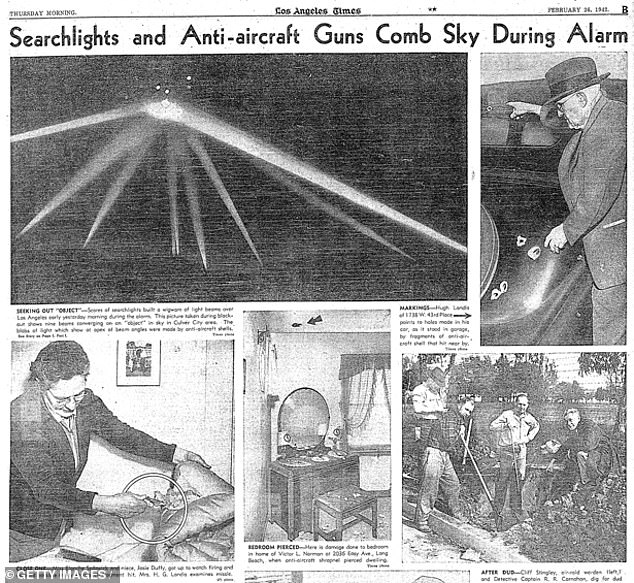
Unveiling the ‘Battle of Los Angeles’: The 2-Hour UFO Siege That Gripped a City in Fear
The Phantom Battle of Los Angeles: A WWII Panic
February 24, 1942
Just 11 weeks after Pearl Harbor, Los Angeles spiraled into chaos when anti-aircraft guns fired wildly into the night sky during a false alarm dubbed the “Battle of Los Angeles.” While fear of a Japanese invasion gripped the nation, historian Dr. Mark Felton reveals the skies were empty—troops had mistaken a weather balloon for enemy aircraft, triggering a deadly misfire.
Panic After Pearl Harbor
Following Japan’s attack on Pearl Harbor in December 1941, the U.S. braced for further strikes. Tensions peaked when a Japanese submarine shelled an oil refinery near Santa Barbara on February 23, 1942—the first mainland attack since 1812. “The West Coast expected a Pearl Harbor-like assault,” Felton explains. “Nerves were frayed, and defenses were on high alert.”
[IMAGE: Anti-aircraft guns light up the LA sky on February 24, 1942. Over 1,400 rounds were fired, but no enemy planes were found.]
The Night of Chaos
At 2:07 AM on February 24, radar detected an unidentified object. Alerts escalated rapidly:
- 2:07 AM: “Yellow alert” for the mystery aircraft.
- 2:22 AM: “Blue alert” declared it hostile.
- 2:25 AM: Sirens wailed, prompting 10,000 air raid wardens to flood the streets.
Searchlights scoured the skies as anti-aircraft units—armed to fire 48 shells per minute—prepared to strike. At 3:16 AM, guns erupted, firing blindly for 20 minutes. Explosions lit up LA as shells detonated mid-air or crashed into homes. Five civilians died from heart attacks and accidents amid the panic.
[IMAGE: LA Mayor Fletcher Bowron at an air raid shelter dedication in 1942. Wardens scrambled when sirens blared.]
The Cost of Confusion
By dawn, 1,440 rounds had been fired, releasing 10 tons of explosives. Unexploded shells pierced roofs and roads, forcing bomb squads to secure neighborhoods. Despite rumors of 50 enemy planes, no wreckage or evidence emerged. Secretary of the Navy Frank Knox later called it a “false alarm,” blaming war jitters and a stray weather balloon.
Felton notes the tragedy stemmed from paranoia: “Gunners imagined planes in the dark. Falling shells looked like bombs, fueling the illusion.” Military leaders faced criticism for mishandling the crisis.
[IMAGE: A demolition squad inspects an unexploded shell. Shrapnel damaged homes across LA.]
Legacy of “War Nerves”
The incident highlights the psychological toll of wartime. With Japan’s carriers nowhere near California, the phantom battle became a cautionary tale of fear outpacing facts. As Felton summarizes, “It was incompetence fueled by expectation—they saw an attack because they believed one was coming.”
Though embarrassing, the episode spurred improvements in radar accuracy and communication. Today, it remains a haunting reminder of how tension can eclipse reason during war.
Word count: ~600


